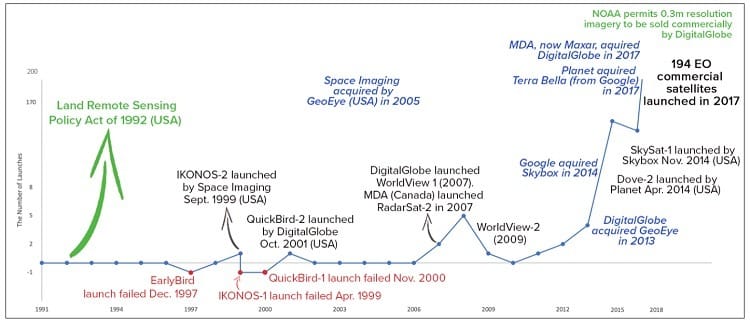The Global Impact of Cheap Satellites and Launches
Table of contents

This past summer we sent one of our MBAs up to Alaska to search for the origins of Alaskan Thunderfcuk and to see if any innovation might be happening that far up north. We managed to come across a great story about an Alaskan service provider, Microcom, that’s working with a satellite firm called Astranis, to provide the State’s population with affordable broadband Internet (Alaskans pay ridiculous prices for broadband). This notion of affordable Internet for all translates into an improved quality of life for the world’s less fortunate populations. There are two main reasons why this is happening now: satellites are becoming smaller and cheaper to build and operate, and the cost of launching rockets into space has plummeted thanks to innovations like reusable rockets. And the impact of these changes just might be a new trillion-dollar industry.
Listening to the Experts
Speaking with experts can often be time consuming and fraught with self-promotion. We find it’s best to speak with founders, as they’re usually extremely passionate about a topic. Passionate people will usually teach you something. Oftentimes, we find such people posting their thoughts in obscure spaces on the World Wide Web where they largely fly under the radar. Why spend time interviewing someone when they’ve already spent days articulating their thoughts for the world to see? Today, we’re going to provide a voice to a few passionate people who have painted a picture of what the impact of cheap satellites and launches looks like. One of those people is Casey Handmer.
Meet Casey Handmer
When you read the LinkedIn profile of a person like Casey Handmer, it makes you wonder what you’ve been doing with your life so far. Probably in his early 30s, this guy wrapped up his thesis on “Gauge Invariant Spectral Cauchy Characteristic Extraction of Gravitational Waves in Computational General Relativity” while working at Hyperloop One and secured himself a job as a Software System Architect at NASA’s Jet Propulsion Laboratory. While our spare time is spent making a third attempt at Rosetta Stone Spanish, Mr. Handmer spends his spare time traveling the world, or blogging about everything from how to maintain a long-distance relationship in Antarctica to why he thinks SpaceX’s Starlink is far bigger than anyone suspects. The latter topic takes the form of a recent 7,241-word article which is as technical (at least for us lay people) as it is verbose, but contains some fascinating bits of information we’re going to summarize for our readers.
Starlink is a Very Big Deal
After a decade of execution, SpaceX is now transforming the space launch industry by steadily increasing capacity and decreasing costs. Consequently, they’re saturating a market worth, at most, a few billion a year. Since there’s not much money to be made in undercutting the competition, they’ve decided to become their own customer. They’re putting all their chips on Starlink, a 30,000 satellite constellation that will unlock trillions in economics value – one of only a few trillion-dollar industries in existence – by enabling the global Internet we’ve all been waiting for.

Internet infrastructure today is extremely expensive to build, and we’re now approaching the limitations of fiber optic cables. As for satellites, a traditional geostationary communications satellite could cost upwards of $500 million and take 5 years from build to launch. Consequently, so far it’s only appealed to niche use cases where customers might pay around $5/MB – about 5,000X the cost of a traditional ADSL connection.
Assuming a 5-year lifespan, Mr. Hamden puts “time to revenue” for a singular Starlink satellite costing $100k to build and launch at one week assuming a subscriber cost of $1/GB. At a ludicrously low usage estimate, a Starlink satellite can deliver 30 PB of data over its lifetime at an amortized cost of $0.003/GB. Compared to undersea cables, that’s 8 times cheaper. Compared to OneWeb’s planned constellation of 600 satellites, SpaceX thinks they’re 17X cheaper. They also think that what pundits like Morgan Stanley have to say – with their interesting portfolio of “space stocks” – is way off.
Says Mr. Hamden, “SpaceX is on the way to becoming an internet service provider and, potentially, an internet company to rival Google and Facebook. Bet you didn’t see that coming.”
Side Effects May Include…
You can’t just send 30,000 satellites up into space without pissing some people off. There are plenty of armchair space experts on Twitter who can quickly throw the monkey wrench of outrage into the cogs of your reusable rocket. Specially, we’re talking space junk and pollution of the night skies.
The obvious question when talking about a constellation of 30,000 satellites, each with a 5-year lifespan, is what to do with all the space junk? When it comes to avoiding collisions, the Starlink satellites are equipped with autonomous collision avoidance systems that use inputs from the Department of Defense to avoid space junk. (Perhaps they’re pulling data from that space radar installation in Kwajalein that can spot marble-sized objects in space.) Satellites that surpass their five-year lifespan will use their efficient ion thrusters powered by krypton to deorbit over the course of a few months. Those that go awol will burn up within 1-5 years due to the low-orbit at which Starlink satellites will fly. Says the company:

While everyone would enjoy seeing some more shooting stars in night skies, not everyone wants to see the satellites themselves. You may recall that SpaceX managed to ruffle the feathers of astronomers across the globe with their recent launch of 60 Starlink satellites. Mr. Hamden states this problem manifested itself because “the first launch’s plane was closely aligned to the Earth’s terminator,” whatever that means. Going forward, he expects that “satellites may be visible during twilight but not long after nightfall, greatly reducing the potential impact to astronomy.” In other words, your desire to explore the universe takes second seat to Mr. Musk’s ambitions of making the world a better place. Once he’s done sorting this planet out, he’ll take you to Mars where you can stargaze to your heart’s content while munching on some delicious soylents.
Smallsats aren’t exclusively used for communications. The next biggest use case is something called “earth observation,” (EO) or what’s also referred to as “geospatial data.” It’s an industry that will also go through significant transformations as we enter an era of cheap launches and even cheaper satellites.
Vertical Consolidation in Geospatial Data
While tooling around our office at Serendipity Labs in Stamford, Connecticut, we sometimes bump into the charismatic Chairman and CEO of RS Metrics, Maneesh Sagar, who also moonlights as an Innovation Fellow at Columbia University in New Yawk. After selling his first company to IBM back in 2002, he started his own venture fund which spawned RS Metrics, a company that extrapolates insights from satellite imagery like metal supply forecasts or the impact of mining companies on the environment. We recently sat down and chatted with Mr. Sagar about the direction his industry is going with respect to the commoditization of satellite imagery.

Just a small portion of the market actually seeks raw satellite imagery. That’s because only the world’s largest hedge funds or governments have the in-house capabilities to extract insights from images. The rest of the market is seeking a platform that allows them to extract customized insights from satellite imagery at regular intervals. According to Radiant Earth Insights, research suggests that the EO commercial data market totaled over $1 billion in 2017 alone, but the value-added services market was triple that at $3 billion. The same publication also produced this handy chart which shows how the availability of EO satellites simple exploded in 2017.

Since there’s enough data to go around, the real value is in interpreting the data. With humans in the loop, machine learning algorithms can identify anything they’re trained to identify, so the winning platforms will be industry agnostic. By next year, every spot on earth will be imaged multiple times per day, which means more big data to process, which means scalability is a key performance factor for a winning solution. The financial industry will be hungry for insights that can be derived from this data to ultimately generate alpha. The speed at which insights can be extracted also becomes a key factor.
While there may be no margins left soon in selling the images, there will be fat juicy margins for those who own the dominant platforms when it comes to extracting insights. Consequently, we’re likely to see an industry that undergoes some vertical consolidation as companies who sell the imagery realize where the real value lies as the industry evolves in the face of cheap satellites and launches.
Conclusion
While Americans obsess over political non-events, or why the Cybertruck window broke, a small number of informed people read and comment on Mr. Handmer’s blog about the tangible potential of a satellite constellation being built right now that might unlock trillions of dollars in value. Trying to find the next Microsoft may not be a great idea for retail investors, but it’s hard not to get excited about what SpaceX is doing with Starlink. The race to the bottom for satellite and launch costs also means we’re able to map every square inch of the planet and analyze what’s going on. Startups like RS Metrics are able to distinguish between Tesla model types from space, while startups like Umbra Lab are now able to see through clouds with their space radar (more on this in a coming article). As retail investors, we’re keen to explore more about what investments we might be able to make that will benefit from these emerging events. Stay tuned.
Sign up to our newsletter to get more of our great research delivered straight to your inbox!
Nanalyze Weekly includes useful insights written by our team of underpaid MBAs, research on new disruptive technology stocks flying under the radar, and summaries of our recent research. Always 100% free.














